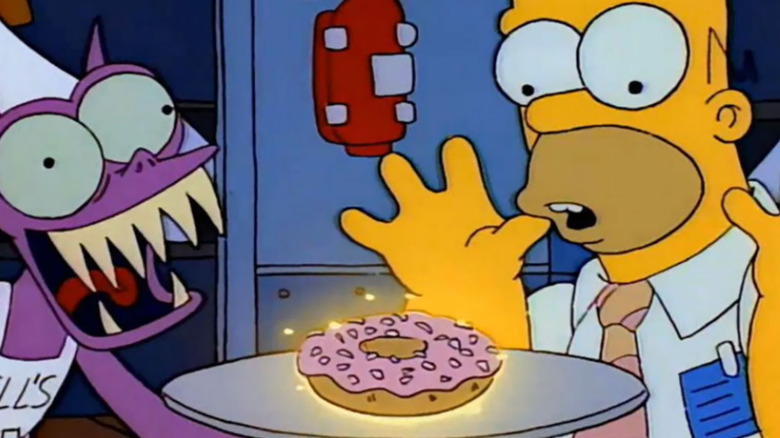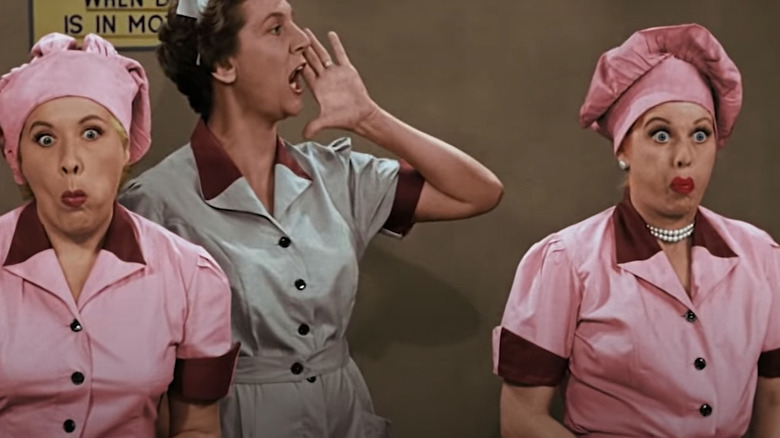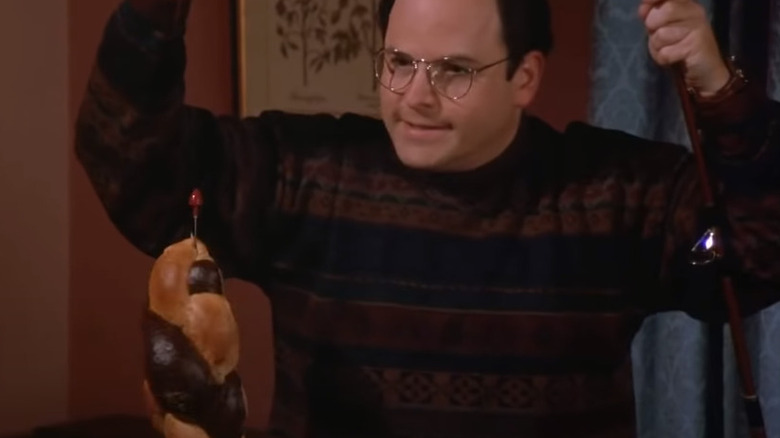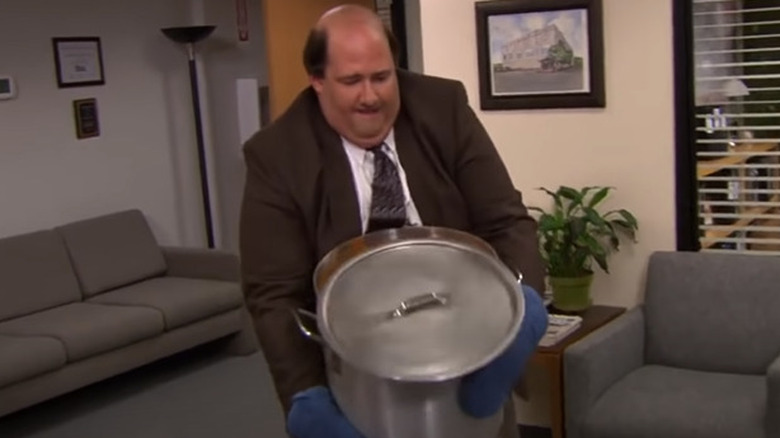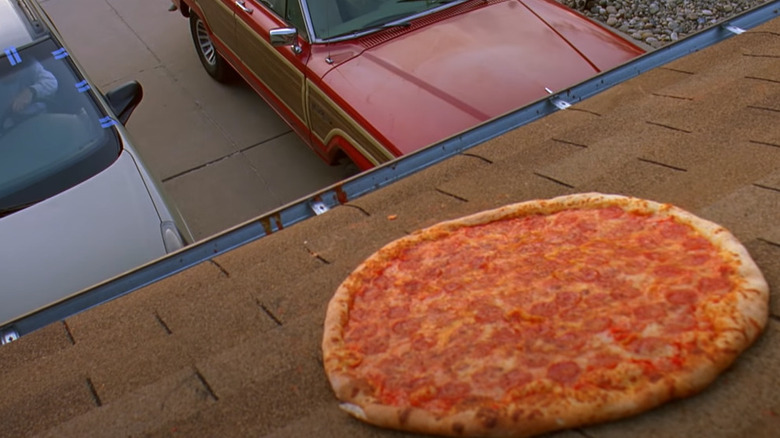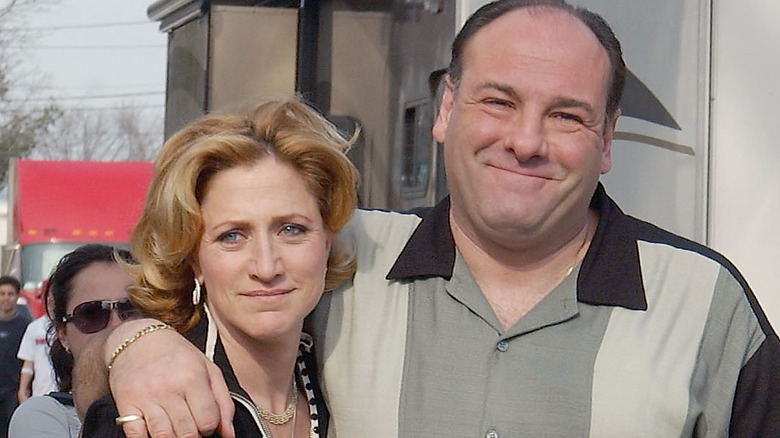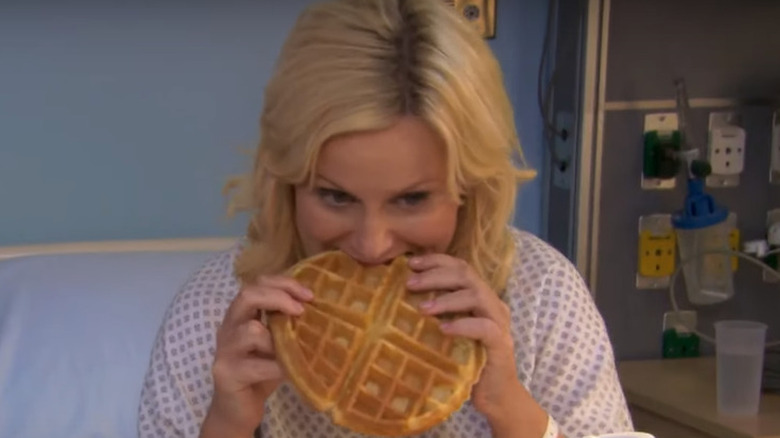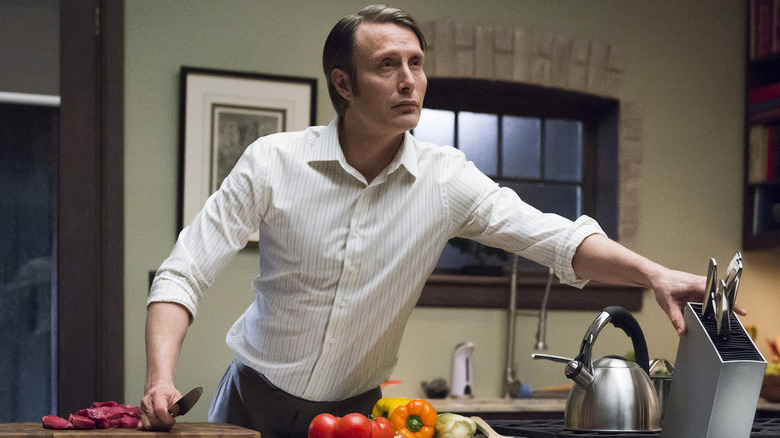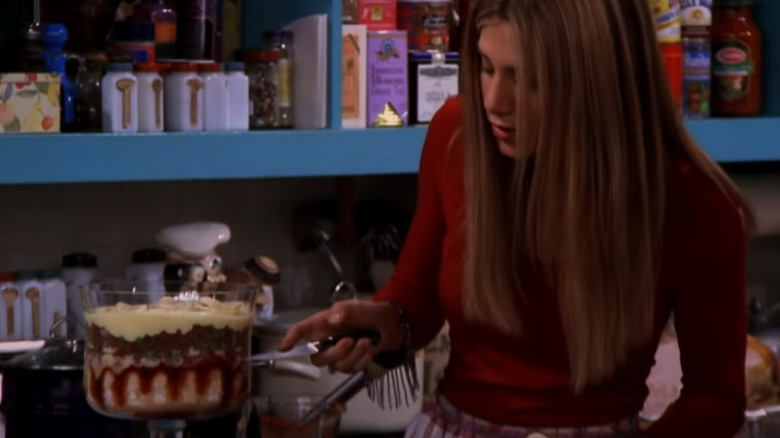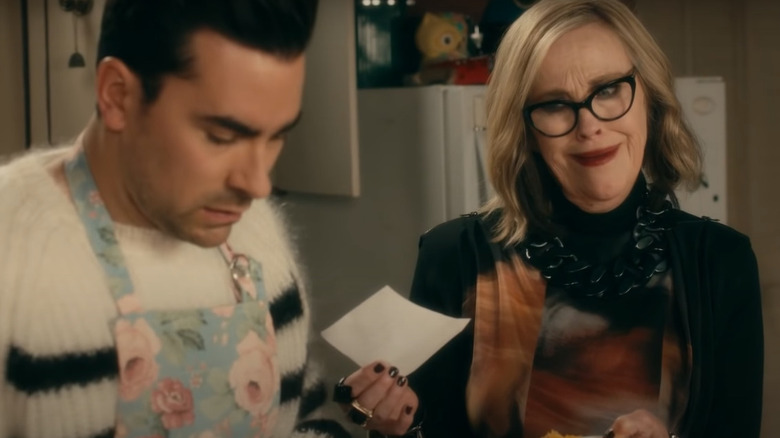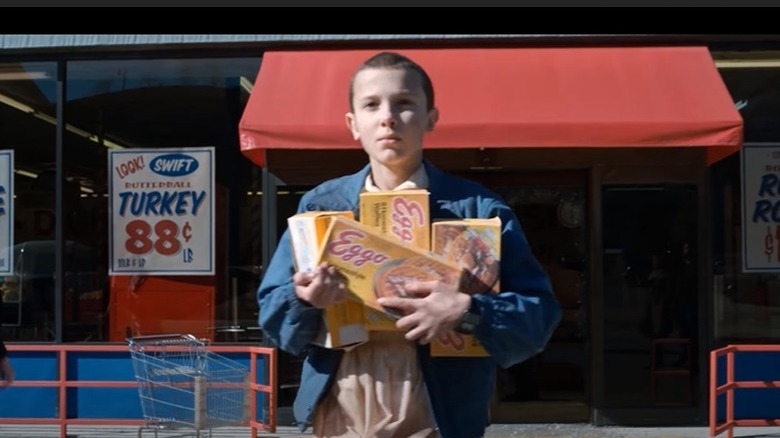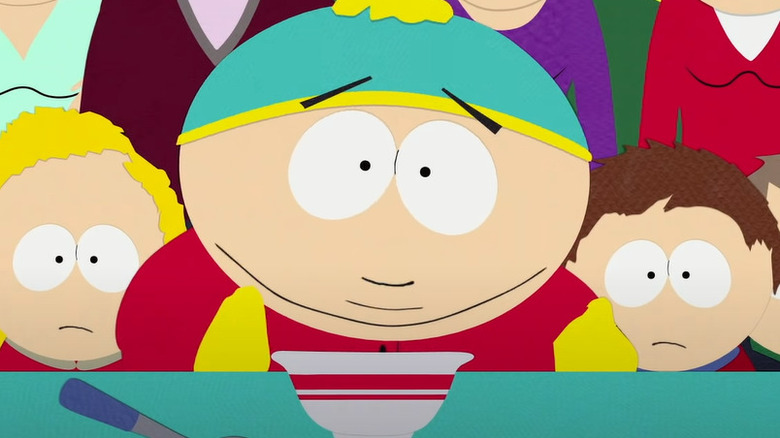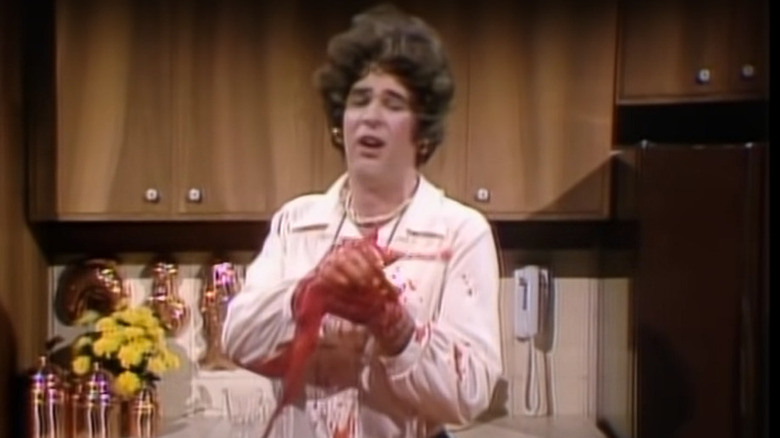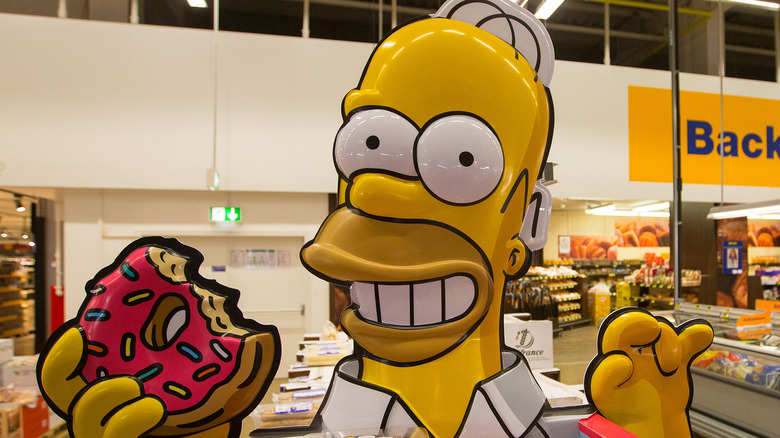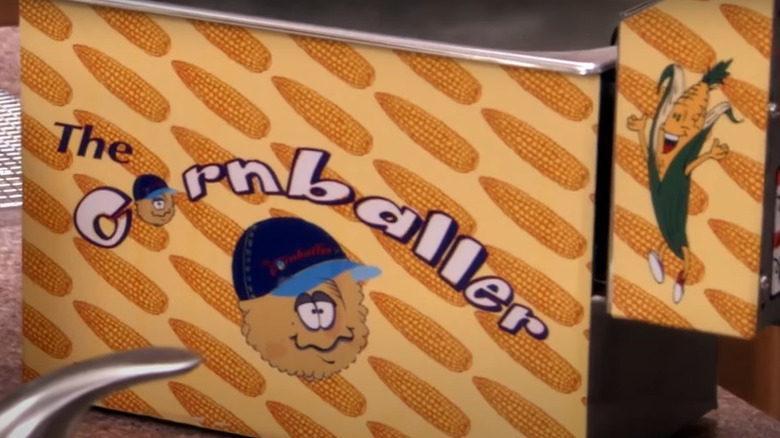The Most Iconic Food Moments In TV History
Food and television — like peanut butter and chocolate, it's a match made in heaven. In fact, whether it's commercials, product placements, or food-based storylines, TV and food have gone hand in hand for nearly a century. From appearances in countless fictional TV series, to the multitude of food-centric networks and cooking shows, TV and food have always maintained a close-knit association.
Which makes perfect sense! After all, a large reason why televised entertainment exists in the first place is to reflect human life, and very few things play a more vital role in human existence than food. The prominent place that food has in TV's landscape is only natural, mirroring the role that all things food-related have in our everyday lives.
Given the innate connection and long standing relationship between food and TV, it begs the question: what are the most iconic food moments in television history? There's no shortage of options –- even if you focus solely on fictional moments, as we'll do here –- but it's a fun task to consider. So let's see what makes the cut, and highlight those eternally iconic food moments that have been etched in TV lore.
Lucy and Ethel work at the candy factory (I Love Lucy)
Even 70 years later, the phrase "Lucy in the candy factory" conjures an instant image of comedic chaos and desperation – whether you've seen the episode or not. The legendary scene from "Job Switching" (Season 2, Episode 1) remains the quintessential piece of food-based comedy, with more than 50 pieces of episode-related merchandise still sold by the Lucy Store in 2022.
Unsurprisingly, the episode holds up, particularly the scenes at the candy factory. No one was better at physical comedy than the rubber-faced Lucille Ball, and the goofy smile plastered on her face, as she bobs around with her hands in a puddle of melted chocolate, remains gut-bustlingly funny. Of course, the episode's truly iconic moment involves Lucy and Ethel on the candy-wrapping line, and their epic failure to keep up with the conveyor belt's speed. The gag gets funnier and funnier as their struggles mount. Before long, the ladies have resorted to simply grabbing handfuls of candy, shoving them into their mouths, their hats, and down their shirts.
While the phenomenal showcase for Ball and Vivian Vance's talents is what most remember, the parallel B-story, of Ricky and Fred (Desi Arnaz and William Frawley) cooking dinner while the ladies go to work, help elevate the proceedings. It may not be as well-known, but the sight of the two men sloshing around a pool of rice helps ensure this episode is routinely ranked among the show's best (via CBS News).
George goes fishing for a marble rye (Seinfeld)
While the "Soup Nazi" may get more publicity, it can't top the character-driven ridiculousness that unfolds as George Costanza (Jason Alexander) attempts to replace a loaf of bread in "The Rye" (Season 7, Episode 11). Based on a real incident from writer Carol Leifer's life (via Vanity Fair), the episode adds layer upon layer of absurdity as it progresses, starting with an aggrieved Frank Constanza fighting for the social grace of being served cake as a guest.
Discovering his father spitefully stole back the titular marble rye he'd brought to a party ("but you gave it to them!"), George concocts a plan to replace the stolen loaf while his future in-laws (the parents of his ill-fated fiancee, Susan) are out of the house. What seems foolproof –- Jerry buys the bread, while Kramer (Michael Richards) distracts Susan's parents with a horse-drawn carriage ride – quickly devolves into an organically silly mess.
First, Jerry arrives too late to purchase a marble rye, and, in desperation, resorts to mugging an old lady for the bread like a common thief ("shut up, you old bag!"). Then, after Kramer feeds his horse cans of Beefareeno ("what a delicious cuisine-o!"), the horse becomes unbearably flatulent, cutting the carriage ride short. This leads to the episode's iconic final shot, and crowning moment: George using a fishing rod to reel up the enormous bread through the window, then proudly holding the line like he'd caught an award-winning trout.
Kevin spills his pot of chili (The Office)
Kevin Malone (Brian Baumgartner) may have been a secondary character, but he always made the most of his time on screen –- never more so than in the iconic cold open where he spills an enormous pot of chili on the office floor. The comically tragic moment, which may be responsible for Baumgarter earning more than seven figures from Cameo as of 2021 (via The Hollywood Reporter), has resonated far beyond its original airing in "Casual Friday" (Season 5, Episode 26).
Though the hilarious-yet-horrifying scene is barely 30 seconds long, it manages to run the gamut of emotions. Kevin's gleeful arrival with his yearly batch of "Kevin's Famous Chili" (a recipe "passed down by Malones for generations"), and his struggle up the stairs, foreshadow danger. But it's still stunning to see him stumble and drop the pot, leading to a perfect pratfall as chili pours onto the floor.
Impressively recorded in a single take, according to Baumgarter (via Page Six), the sight of a panicked Kevin hopelessly scooping spilled chili from the carpeted floor, using any available office supply as a makeshift shovel, is one of the greatest in the show's history –- food-based or otherwise. The moment is so beloved, in fact, that NBC released a version of the recipe in 2022, hidden in the Peacock user agreement (via People).
Just make sure you store it in a container with a secure lid.
Walt tosses a pizza onto the roof (Breaking Bad)
Walter White (Bryan Cranston) may have been the one who knocked, but if the person on the other side of the door didn't answer? Well, he was prone to lash out impulsively –- even if the only victim at his disposal was a gigantic pizza.
In a series chock full of memorable moments, few may be as iconic as an angry Walt frisbeeing a pizza onto his roof in a white-hot rage (pun intended). Featuring a restaurant that doesn't cut their pizza –- then they "pass the savings on to you," Badger (Matt Jones) later explains –- the uncut pie was crucial to the scene's success, ensuring it landed on the roof in perfect condition.
Beyond the astounding fact that the pizza flies and lands so elegantly, the scene from "Caballo sin Nombre" (Season 3, Episode 2) may resonate because it captures Walt in a nutshell: assuming he can outsmart everyone, and charm his way into anything. His belief that a halfhearted peace offering of fast-casual Italian food ("I got dipping sticks!") can wipe away the recent revelation that he'd become a drug dealer was laughable -– and heartbreaking.
The scene proved so popular that fans have eagerly attempted to recreate the feat at the actual house in Albuquerque since its original airing. However, the pizza prank's frequency became such a nuisance to the home's owners, that none other than Vince Gilligan had to step in and implore fans to stop (via Time).
Tony has onion rings as his last meal (The Sopranos)
Few television series are more iconic than "The Sopranos." Helping launch a "Golden Age of Television" (via CNN), the show's impact is undeniable, and evident in nearly every prestige drama since the turn of the century. The story of the New Jersey mob has remained immensely popular since ending, even leading to the release of a prequel film, "The Many Saints of Newark," in 2021.
But nothing surrounding the trials and tribulations of Tony Soprano (James Gandolfini) can match the incessant fervor generated by the final moments of the series finale, "Made in America" (Season 6, Episode 21). The deliberately provocative choice to cut to a silent, black screen for 30 seconds –- as Tony scarfs down onion rings at Holsten's Diner –- led to a years-long debate: did Tony Soprano die during the show's final moments?
Yes, he did -– a fact finally confirmed by series creator, David Chase, in 2021 (via Hollywood Reporter). But enjoying a fistful of greasy junk food as his last meal was a fitting way for Tony to go. After all, whether he was noshing on cold pasta or snacking on deli meats, Tony never stopped eating –- right up until his very last moments.
The cultural footprint left by the show means this scene is not just one of the most iconic food-based TV moments; it's one of the most iconic moments in all of TV history.
Leslie Knope eats waffles with the flu (Parks and Recreation)
Leslie Knope (Amy Poehler) loved waffles, as much as –- and, potentially, even more than –- her friends (as long as "work is third"). Her adoration for waffles was one of the character's defining traits, something perfectly illustrated in "Flu Season" (Season 3, Episode 2), beginning with the revelation that she had spent more than $1000 on waffles alone the previous year at Pawnee's famous JJ's Diner.
The episode that renowned TV critic, Alan Sepinwall, called the one he'd recommend to someone who'd never seen the show, it includes showcase moments for every major character. But as one of the earliest indications of the budding romance between Leslie and her future husband, Ben Wyatt (Adam Scott), it stands above all other waffle-based moments from the show.
After Leslie is hospitalized with the flu, she sneaks out against all medical advice, and delivers a passionate and successful sales pitch for the upcoming Harvest Festival (in a performance Ben likens to a "flu-ridden Michael Jordan" during the NBA Finals). She returns to the hospital afterwards, where Ben brings her a container of his family's homemade chicken soup, and a takeout container with waffles from JJ's. Leslie snubs the soup, of course, leading to the iconic image of her housing a waffle with her bare hands.
Hannibal does, well, anything in the kitchen (Hannibal)
No actor has ever embodied Hannibal Lector's utter swag and brutality quite like Mads Mikkelson (sorry, Sir Anthony). Playing a pre-imprisoned version of everyone's favorite cannibal on the prequel series, Mikkelson's take was simply scrumptious. The thrill of seeing the sociopathic genius outsmart everyone as the Chesapeake Ripper -– battling the FBI, and his BFF, Will Graham (Hugh Dancy) –- was a treat for viewers, though nothing may have been more entertaining than watching Hannibal cook.
Maybe it's cheating to avoid picking one scene or episode, but this entire series is a bevy of iconic food moments. While there's much more to Hannibal than his cannibalistic cravings, the lascivious nature of one dining on human flesh will always entice viewers. And, let's be honest: no one's ever made cannibalism seem appealing the way this show did. Every trip to the kitchen with Hannibal was a delight, creating decadent dishes that were both mouth-watering and stomach-churning.
Perhaps we have the philosophy of creator, Bryan Fuller, to thank for making human flesh seem so appetizing. After all, he didn't view "Hannibal" as a TV show, but rather "a pretentious art film from the 80s" (via The Guardian). This attitude may have limited the show's broad appeal, but it was key to its cult following, which inspired an April Fool's joke from Hulu in 2014: a fake trailer for a new show, "In the Kitchen with Hannibal" (via Business Insider).
Rachel makes the world's worst Thanksgiving dessert (Friends)
There's no denying how close the main characters were on "Friends," and no scene may demonstrate their collective bond better than their reactions to Rachel's trifle in "The One Where Ross Got High" (Season 6, Episode 9). Between Rachel's (Jennifer Aniston) oblivious eagerness to show off her baking efforts, and the group's incredible willingness to pretend the dessert is actually good ("it tastes like feet!"), the episode remains iconic because it stays true to who the core group was.
Rachel's struggle to overcome her spoiled childhood was one of her defining characteristics, and her desire to establish true independence drove much of the character's journey. This is evident in her decision to make the "only" dessert for that year's Thanksgiving meal, as well as the almost-incomprehensible way she naively follows a cookbook's bizarre recipe -– which, thanks to pages being stuck together, is actually a combination of an English trifle and shepherd's pie.
The pride with which she explains her ingredients ("beef, sauteed with peas and onions") is almost too much to handle. Ditto her friends' efforts to simultaneously spare her feelings and avoid eating the nasty dessert, complete with over-the-top yummy mannerisms taught by Joey (Matt LeBlanc) -– who, of course, actually did like the odd dessert ("Custard? Good! Jam? Good! Meat? Good!"). The episode remains a classic Thanksgiving-themed episode, even inspiring a trifle recipe in tribute (via Food Network) -– sans the savory components.
David and Moira can't fold in the cheese (Schitt's Creek)
One of the defining moments between Moira and David Rose (Catherine O'Hara and Dan Levy), the scene of mother and son cooking from "Family Dinner" (Season 2, Episode 2) is both relatable and eye-rolling. Coming after Moira's insistence that she used to cook her "mother's enchilada recipe" for the family ("yes, well, if that's the way you remember things, sweetheart," Johnny replies), the Rose matriarch ropes in her son to help prove her right.
Commandeering the Schitt's kitchen, Moira barks directions at David while he cooks, until the line that stops them cold: "fold in the cheese." Baffled by the direction ("I don't know how to fold broken cheese"), he asks for clarification, but is only giving variations of the same line. "Just fold it in," his mother repeats several times –- as if simply saying the phrase over and over would somehow clarify things -– until he finally snaps ("you fold it in, then," he says storming away, as she incredulously replies, "don't you dare!").
Eventually, David finds a video online demonstrating the cooking technique, such as this one (via Delish), and Moira apologizes to her son, admitting, in a rare display of humility, that she did not, in fact, know what "fold in the cheese" meant. That tricky balance of humor with the sentimental was a specialty of "Schitt's Creek," and, like this iconic food moment, played a big hand in the show's enduring popularity (via New York Times).
Eleven steals an armload of Eggos (Stranger Things)
The characters may have rapidly grown since we first laid eyes on the Hawkins, Indiana party in 2016. But the sight of a bald-headed Eleven (Millie Bobby Brown) devouring Eggo waffles may still be the first thing that springs to mind for many fans. The connection between Eggos and "Stranger Things" is so immense that the circular breakfast treat played a prominent role in the mobile game, "Stranger Things: 1984," where players had to collect eight Eggos in order to unlock Eleven (via All Gamers).
While it's difficult to dispel the notion that Eleven and Eggos is little more than a modified version of "E.T." and Reese's Pieces, the character's obsession with the processed food still resonated in many ways with fans (via Food & Wine). And one scene in particular, from "The Monster" (Season 1, Episode 6), best displays what makes the telekinetic girl's love for frozen, processed waffles so iconic.
When a dirty, ravaged Eleven ("El, for short") goes to a store, and confidently grabs several boxes of Eggos from the freezer, it's the moment she truly breaks free from her lab-hidden past. Embracing her new friends (calling a store employee a "mouth breather," a la Mike), and autonomy over her powers, she confidently struts out of the store without paying for the Eggos –- leaving a trail of exploding glass in her wake as she wipes a drop of blood from her nose.
Cartman serves chili con padres (South Park)
A perfect portrayal of the disturbing duality of Eric Cartman's personality, "Scott Tenorman Must Die" (Season 5, Episode 4) deftly balances the 8-year-old's youthful naivety, with the sociopathic tendencies that drove his later attempts to, among other things, rig the Special Olympics. In an episode ranked as one of the best of the 2000s (according to AV Club), the pitch-black turn the plot takes in its final minutes is utterly bone-chilling -– or, as chilling as a construction-paper animated cartoon can be, at least.
After all, this is the episode where Cartman's fury at an older bully –- the titular Scott Tenorman, who conned him out of a measly $10 -– leads him to, literally, murder the bully's parents ... grind them up ... cook them into a chili ... then feed it to the bully.
Yikes.
Beyond the revelation that Cartman was willing to murder someone to get revenge, what makes this food-based moment so iconic is the way the final twist comes out of nowhere. Frankly, nothing about the story's ho-hum proceedings provide any indication of the darkness lurking in the final act, during Cartman's impromptu Chili Carnival. And it's impossible to be anything but stunned as Cartman outlines his meticulous and murderous plan, ending with him joyfully licking the newly-orphaned boy's tears of "unfathomable sadness" as Stan and Kyle agree it's best to never cross Cartman.
Dan Aykroyd cuts a finger as the French Chef (SNL)
One of the defining sketches from the original Not Ready For Primetime Players run, Dan Aykroyd's silly, satirical take on the uniquely charismatic Julia Child, as "The French Chef," remains just as funny in 2022 as it was when it first aired (Season 4, Episode 8). A lovingly gentle impersonation of a true American icon –- whose personal kitchen is on display at the Smithsonian -– the sketch not only delighted comedy fans across the country; it was loved by the chef herself, who "thought it was terribly funny," according to the book, "The French Chef in America" (from an excerpt via My Little Bird).
Based (somewhat) on a real-life incident where the famed chef did, in fact, cut her hand on TV, the famous sketch doesn't mock the titular "French Chef" as much as exaggerate her quirky mannerisms. The first half of the sketch includes some goofy wordplay ("spread it on a sa-hall-tine"), and a long-winded endorsement for saving the liver (which comes back several times throughout the sketch). But what most people remember, of course, is the slight cut when deboning a chicken ... that just keeps gushing and gushing.
Dan Aykroyd was never better than when he flops around stage, hopelessly trying to stem the bleeding. Eventually, having lost buckets of blood, Aykroyd-as-Julia keels over –- imploring, one last time, to "save the liver!" before passing out.
Homer sells his soul for a donut ("The Simpsons")
Eating is one of Homer Simpson's greatest joys, with his catchphrase, "mmm ... [insert food item]," being used on the show 110 different times as of 2014, according to Thrillist. His willingness to do any and everything for a snack led to one of the greatest and funniest Treehouse of Horror segments of all time (via Vulture), when Homer sells his soul for a donut (Season 5, Episode 5).
While it's well-established that Homer loves donuts, it's still sort of shocking to witness a man commit himself to eternal damnation for a single breakfast pastry. But nothing may better encapsulate just who Homer Simpson is than his eagerness to sell his soul for a single donut to the devil (played by Ned Flanders, since it's "always the one you least suspect").
The segment is loaded with hysterical moments and lines, including Homer getting sent to Hell ("mmm ... forbidden donut"), his unstoppable appetite for donuts while being tortured, and Homer's trial before a "jury of the damned!" -– which includes Lizzie Borden, John Wilkes Booth, and the then-still-alive Richard Nixon. The trial, prompted by Lisa, who points out her father's right to due process as an American, ends with Homer able to keep his soul. But there's a catch, of course, and the story is capped by the silly sight of Homer's head turned into a giant, edible donut ("I'm so sweet and tasty!").
The cornballer burns the Bluths ... again and again (Arrested Development)
It may not have been the type of lesson that required the services of a certain one-armed man, but that's probably because no one needed to be taught that you don't touch the cornballer. The telltale burns left by the kitchen appliance –- that was illegal everywhere but Mexico (where it was also banned, but still sold by George Sr.) –- were lessons enough for the extended Bluth clan.
An essential tradition of the Bluth family, the cornballer made appearances in eight episodes throughout the show's run (via NPR), beginning with its first one in "Bringing Up Buster" (Season 1, Episode 3). In a scene that establishes the cornballer's myth and monumental danger (each illustrated during the flashback to a cornballer infomercial co-starring Richard Simmons), the dangerously hot, iconic deep fryer leaves its mark by scalding Michael (Jason Bateman) –- twice -– and Tobias (David Cross).
Proving its inherent danger and comedic potential, the cornballer left a lasting impression on viewers. From the Spanish-dubbed infomercial version ("Soy loco por los cornballs!") to Michael screaming at the machine ("cornballing piece of ... !"), the cornballer was the gift that kept giving laughs – and scars.
